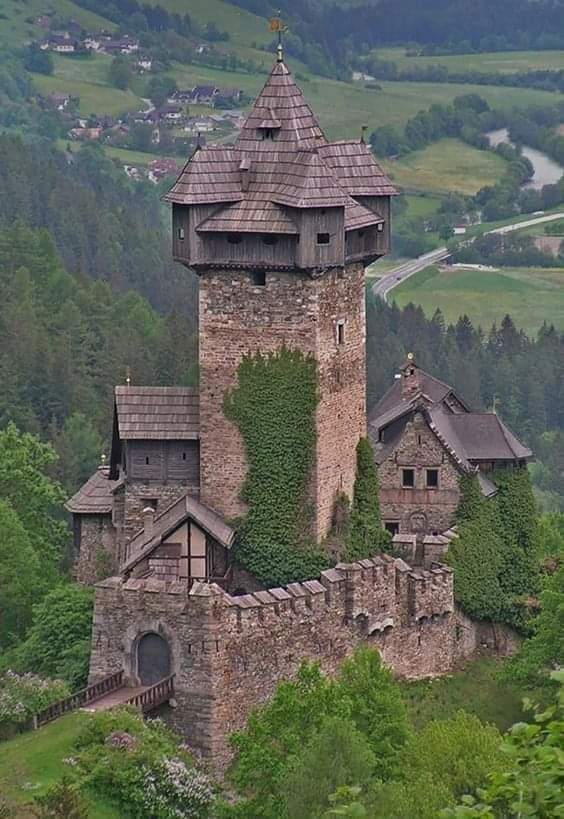Nestled in the heart of Carinthia, Austria, Niederfalkenstein Castle stands as a remarkable testament to medieval fortification and the architectural ingenuity of its time. As part of the larger Falkenstein fortification complex, this well-preserved castle provides an intriguing window into the past. While its counterpart, Oberfalkenstein, lies in ruins, Niederfalkenstein has withstood the test of time, preserving the grandeur of a medieval stronghold. The castle’s enduring presence, historical significance, and impressive architectural design make it a compelling landmark in Austria’s cultural landscape.
Niederfalkenstein Castle occupies a strategic position on a rocky promontory along the southwestern slopes of the Reisseck Group within the Hohe Tauern mountain range. Overlooking the picturesque Möll Valley, the castle rises to an elevation of 843 meters (2,766 feet) above sea level, granting it a commanding view of the surrounding terrain. This elevated position not only provided natural defensive advantages but also underscored its importance as a fortress in medieval times. The structure was carefully designed to integrate seamlessly with its rugged surroundings, ensuring maximum protection from potential invaders.

Adding to its significance is the castle’s proximity to the Tauern Railway line, which was inaugurated in 1909. Originally, the railway passed beneath Niederfalkenstein through a 67-meter (220-foot) tunnel carved into the rock. However, between 1971 and 1973, a major transformation took place when the tunnel was replaced by the Falkenstein Bridge. This 396-meter (1,299-foot) arch bridge now connects Ober- and Niederfalkenstein, serving as both a crucial transportation link and an engineering marvel. As the longest bridge on the line and one of Austria’s most impressive railway structures, it symbolizes the intersection of medieval heritage and modern innovation.
While Niederfalkenstein remains largely intact, its counterpart, Oberfalkenstein, has been reduced to ruins, though traces of its former grandeur persist. The site includes remnants of a Bergfried keep, moats, and the foundational structures of a Romanesque palas, hinting at its past prominence. Among the few preserved elements is a chapel dedicated to John the Baptist, which was first mentioned in historical records in 1246. In 1772, the chapel underwent significant expansion in the Baroque style, and it remains in use today, offering a rare glimpse into the religious and cultural aspects of medieval fortress life.
The origins of Niederfalkenstein Castle can be traced back to 1164, when it was first documented as Valchenstain Castle. The name likely derives from the Proto-Germanic term “walhaz,” meaning “foreigner” or “stranger,” possibly referencing an early Romance-speaking (Italian) settlement in the area. This linguistic connection suggests that the castle’s early inhabitants may have descended from the former Roman city of Teurnia, whose people migrated to the valley during the Slavic settlement of the Eastern Alps around 600 AD.
One of the earliest known lords of the castle was Gumpoldus de Valchenstein, a vassal of Count Engelbert II of Gorizia. The Counts of Gorizia, members of the influential Meinhardiner dynasty, played a crucial role in shaping the region’s political landscape. Serving as Vogts (protectors) of the Benedictine Millstatt Abbey, they maintained close ties with the Falkenstein lords, further elevating the castle’s status within Carinthia’s medieval hierarchy.
By the late 13th century, the Falkenstein dynasty had reached its end, leading to the division of the estate into Upper and Lower Falkenstein. As a result, these castles were granted to various noble families by the Counts of Gorizia. In 1394, Count Henry VI pawned Oberfalkenstein to the Habsburg Duke Albert III of Austria, marking the beginning of the castle’s long association with the Habsburgs. Later, in 1460, Emperor Frederick III seized Oberfalkenstein after defeating Count John II of Gorizia, further consolidating Habsburg control over the region. Meanwhile, ownership of Niederfalkenstein changed hands multiple times, including a brief period under the Carinthian knight Andreas von Graben.
In 1504, Emperor Maximilian I transferred Niederfalkenstein to Count Julian of Lodron as a pawned estate. Following Lodron’s death, Christoph Frankopan acquired the castle and undertook extensive restoration efforts to preserve its structural integrity. However, by the early 19th century, the castle had fallen into decline. When Austrian mountaineer Joseph Kyselak visited in 1825, he noted its deteriorated condition, signaling a period of neglect.
Despite this decline, the castle saw a resurgence in 1905 when efforts to restore it commenced. Unfortunately, in 1969, a devastating fire caused by a burglary inflicted significant damage, requiring further restoration work. Despite these setbacks, Niederfalkenstein Castle remained resilient. Today, it stands as a privately owned heritage site, yet it opens its doors to visitors during the summer months, allowing the public to experience its historical and architectural splendor firsthand.
Niederfalkenstein Castle is more than just a medieval stronghold; it is a living monument to the region’s rich history and enduring architectural legacy. Its strategic location within the Hohe Tauern mountains, its connections to powerful dynasties, and its survival through centuries of political and social upheaval make it a fascinating subject of historical study. As it continues to captivate visitors, the castle serves as a bridge between past and present, preserving the legacy of a bygone era while remaining a cherished landmark in Austria’s cultural heritage.
The story of Niederfalkenstein Castle reflects the broader history of medieval European fortifications—built for defense, adapted for changing times, and ultimately preserved for future generations to appreciate. Whether viewed as a symbol of medieval power, a remarkable feat of architectural resilience, or simply a picturesque historical site, the castle remains a compelling destination for history enthusiasts, architecture admirers, and travelers seeking to immerse themselves in Austria’s storied past. Through ongoing preservation efforts, Niederfalkenstein Castle continues to stand tall, offering an enduring connection to the medieval world and ensuring that its legacy will endure for generations to come.





